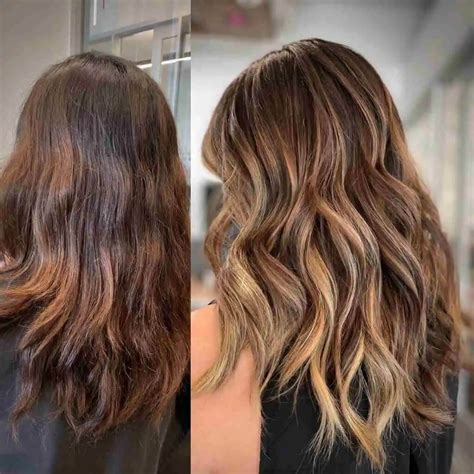Definition of Balayage
Balayage is a French hair coloring technique that creates a natural, sun-kissed look. Hair is hand-painted with lightener, allowing for seamless transitions and dimensional colors.

Balayage Partial vs. Full: The Key Differences
Coverage
- Balayage Partial: Targets specific areas of the hair, such as the ends or face-framing pieces, to enhance or brighten the natural hair color.
- Full Balayage: Applies lightener to a larger portion of the hair, creating a more dramatic and noticeable transformation.
Intensity
- Balayage Partial: Typically creates subtle, natural-looking highlights that blend seamlessly with the base color.
- Full Balayage: Produces more intense and contrasting highlights, giving a more dramatic effect.
Application Process
- Balayage Partial: Requires less time and product than a full balayage, as it targets specific areas.
- Full Balayage: Is a more time-consuming and product-intensive process due to the larger area of coverage.
Benefits of Balayage Partial and Full
Balayage Partial
- Enhances natural hair color
- Adds dimension and brightness
- Low maintenance
- Can be customized to suit individual preferences
Full Balayage
- Creates a bolder and more noticeable transformation
- Adds depth and volume to the hair
- Suitable for those seeking a significant color change
- Can be personalized to achieve desired results
Which Type of Balayage Is Best for You?
The ideal choice depends on personal preferences and hair goals:
- For a subtle, natural look and low maintenance, consider a balayage partial.
- For a dramatic and transformative effect, a full balayage is recommended.
- Consult with a hairstylist to determine the best option based on your hair type and desired results.
Common Mistakes to Avoid
- Over-processing the hair, leading to damage
- Applying lightener too close to the roots, creating an unnatural look
- Using low-quality hair care products, causing fading or brassiness
- Neglecting regular trims to remove split ends
Creative Inspirations
- Reverse Balayage: Inverted balayage technique that darkens the ends and lightens the roots.
- Foilayage: Hybrid technique combining balayage with foils, allowing for precise placement and control.
- Shadow Root: Subtle darkening of the roots to create a natural, blended look.
Tables for Comparison
| Feature | Balayage Partial | Full Balayage |
|---|---|---|
| Coverage | Specific areas | Larger portion |
| Intensity | Subtle highlights | Intense and contrasting |
| Application Time | Less time | More time |
| Maintenance | Low maintenance | Requires regular upkeep |
| Suitability | Natural enhancement | Bold transformation |
Discussion Points to Consider with Audience
- What are your hair goals and desired level of transformation?
- Discuss the pros and cons of each technique based on your individual needs.
- Consider your budget and availability for maintenance.
- Explore creative variations to personalize your balayage experience.
- Emphasize the importance of consulting a professional hairstylist for optimal results.
